Yes, you’ve heard before that signal chain placement is subjective. BORING. We all start out with guidelines and the compressor pedal is no different. So where should you put it?
Generally, a compressor should be close to the start of your signal chain. Specifically, it should be positioned close to your guitar. This helps you control the dynamics, shape your tone, optimize gain staging, and preserve your signal while also reducing the noise before interacting with other FX.
What’s the Best Way to Place A Compressor?
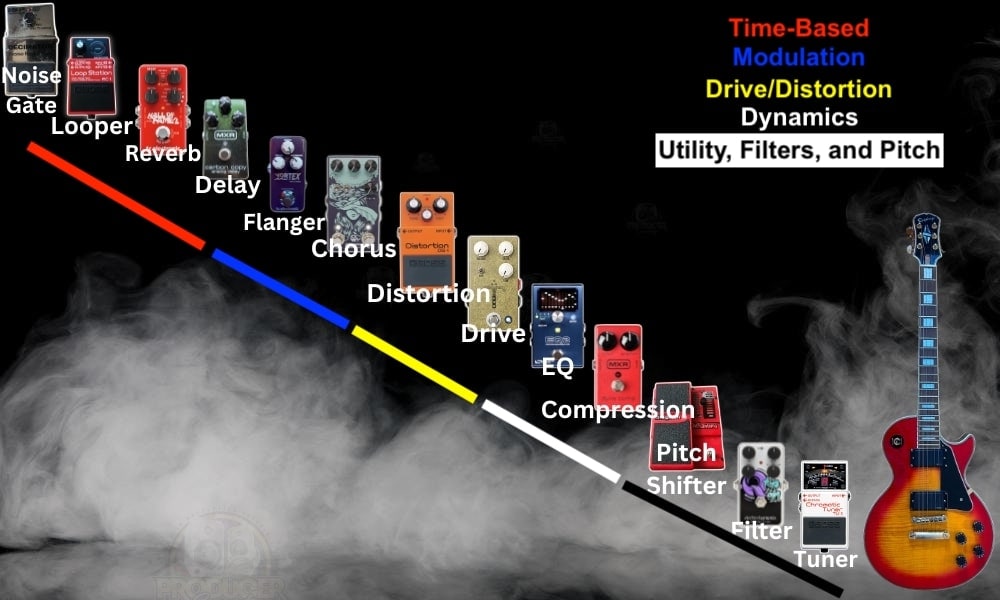
Utility (Tuner) > Filter/Wah > Pitch > Dynamics > Drive/Distortion > Modulation > Time
In nearly all cases, including the way I have my board set up now, I have the compressor near the start of the chain. As I type this, my Filter is actually first, then my tuner, then the pitch shifter, and then the compressor. With what I want and need, this is perfect.
Other Ways to Place the Compressor in Your Chain
1) Put The Compressor Between Your Drive & Distortion
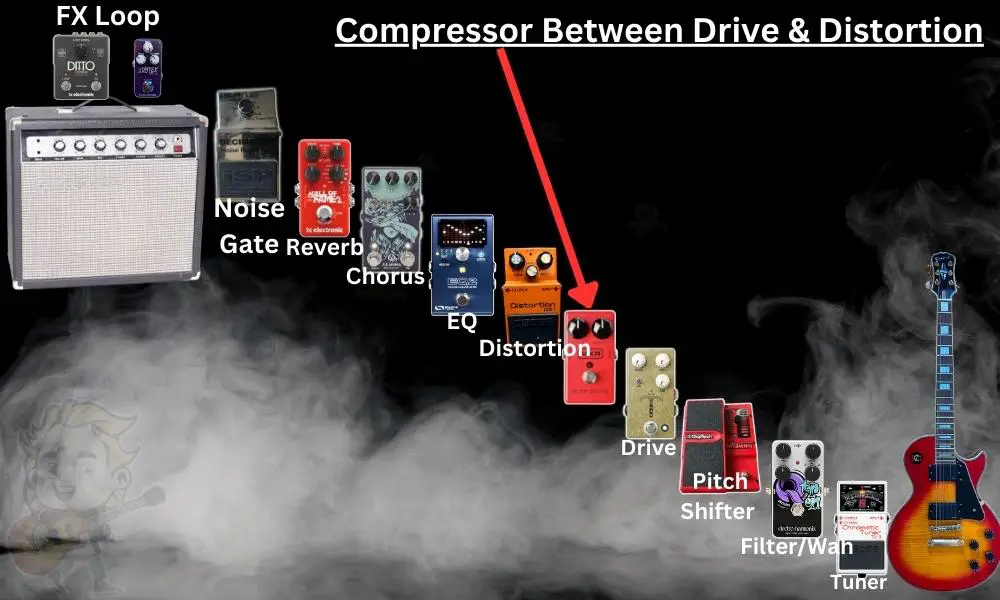
Setting up your compressor after your overdrive and before your distortion pedal is an excellent way to increase the sustain, tame your wild overtones, and make your rhythm guitar fit in a busy mix with other mid-range instruments like the piano, keys, and synths.
Wampler Pedals shows it best by demonstrating that the tone surely gets much darker as the harmonic overtones from the overdrive get squashed.
If you set your compressor pedal up in a way that the sustain and the blend are all the way up while the attack is at around 10 O’Clock, the compressor’s tone knob begins to act like a treble booster.
Using the compressor after the overdrive provides for more note distinction in a severely saturated sound, as the overdrive pedal may sometimes blur the attack and decay of notes.
When you feed this compressed signal into a distortion pedal, not only do you make up for the lost volume post-compression, but also bring out harmonics based on a compressed, even tone.
This works especially well for powerfully strummed chords and riffs that need attitude and presence but whose harmonic overtones should not interfere with the other instruments.
2) Place An Analog Compressor After Drive and EQ
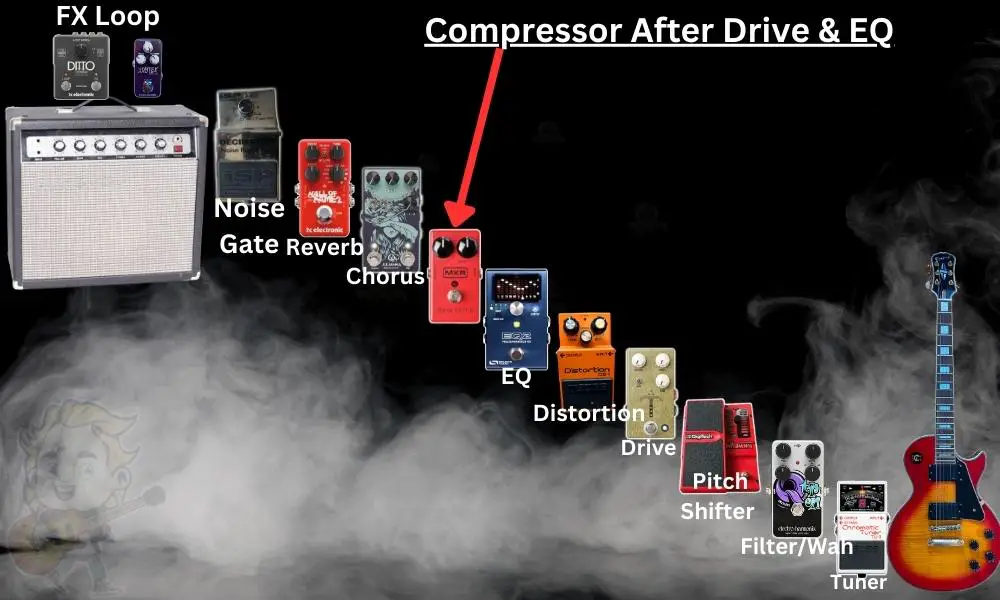
The preamp pedals shape the EQ and gain structure, and the emulation pedals provide distinct coloration and characteristics.
Placing the compressor pedal after them can further sculpt the frequencies and dynamics of the signal following these pedals, enabling you to obtain a more refined tone.
Some emulation pedals concentrate on simulating the breakup and distortion characteristics of tube amplifiers. Placing the compressor after the preamp and emulation pedals lets the compressor respond to the mimicked amplifier breakup.
As the signal reaches the desired breakup point, the compressor can be used to shape the dynamics and sustain the distorted signal, adding a level of realism to the simulated amplifier’s response. But make sure you’re using an analog compressor pedal for this setup.
3) Place Your Compressor Pedal Before A Noise Gate Pedal
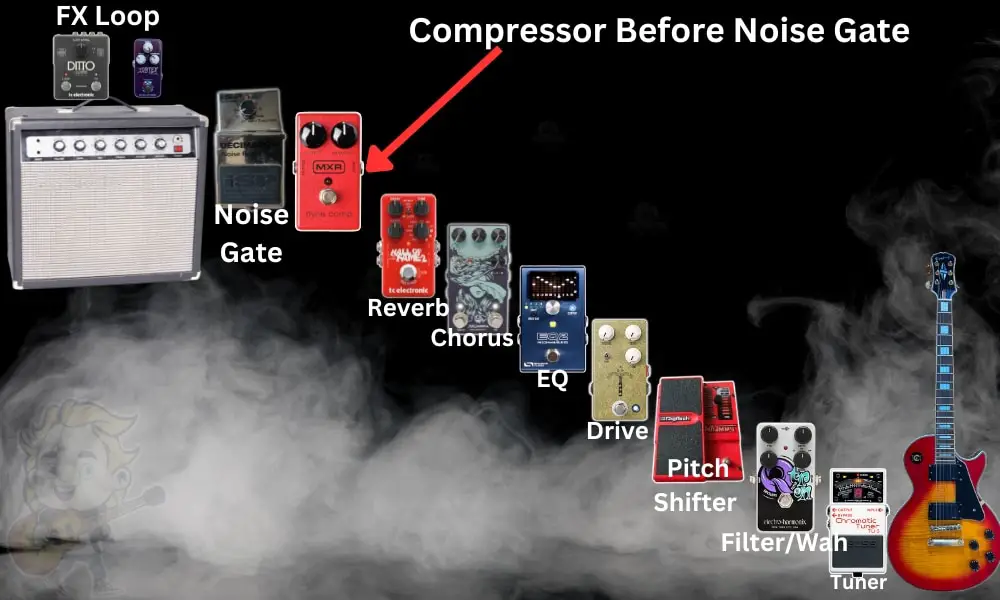
The functional aspect of this placement is that the compressor’s impact helps to eliminate erroneous triggering or sudden cutoffs, which results in an overall smoother and more natural gating effect.
The tonal aspect of this placement is that placing the compressor pedal before the noise gate allows the noise gate to perform more effectively without cutting off the desired and necessary sustain or affecting the natural decay of the notes.
How this works is that the compressor maintains the appropriate sustain and natural decay of the signal while the noise gate reduces unwanted noise during quiet intervals.
This guarantees that the noise gate has no detrimental influence on the overall dynamic curve and emotion of your performance.
The compressor preserves the original flavour and dynamics of your performance, allowing for a smooth transition between sustained notes and quiet passages.
4) Place Your Compressor Pedal In The FX Loop Of Your Amplifier
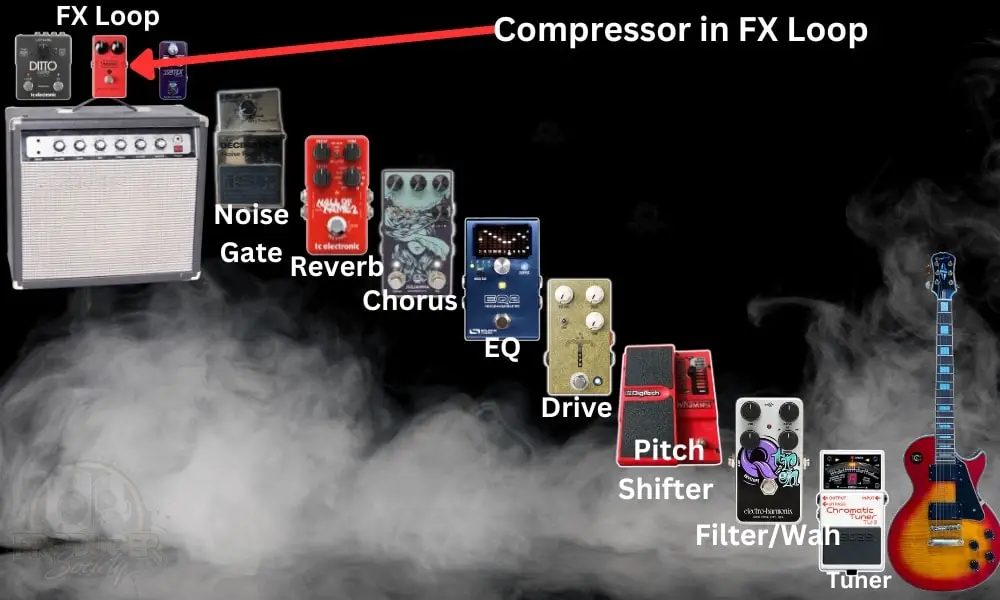
Pro Sound HQ describes very well how the compressor, when put in the FX loop, works after the amplifier’s preamp stage, which completely changes the point of entry of the compression.
The preamp boosts the signal of your guitar and adds character to your tone. By putting the compressor after the preamp’s gain and EQ stages, you gain control over your dynamics and your sustain and are able to gain stage the overall signal flow.
The compressor in the FX loop can be used creatively as a boost for specific effects or during solos. Set the compressor to a lower compression ratio and a faster attack to operate as a clean volume boost.
By using the compressor during specific sections or for solos, you can generate a louder, more present sound without adding artifacts or distortion. This is especially useful in a cleaner guitar tone context.
Since we’re putting the compressor in the FX loop, which comes after the preamp section, rolling your guitar’s volume knob won’t affect the compressed signal.
Since the compressor is in the FX loop, you can experiment with greater compression ratios and longer attack/release periods to generate luscious, ambient swells or pad-like sounds.
You can build a wall of sound that grows and persists nicely by using the compressor’s ability to sustain and alter the dynamics. Combine this with loudness swells or gradually bring in the swells using the guitar’s volume knob for ethereal and ambient soundscapes.
5) Set Your Compressor Pedal Up For Parallel Compression
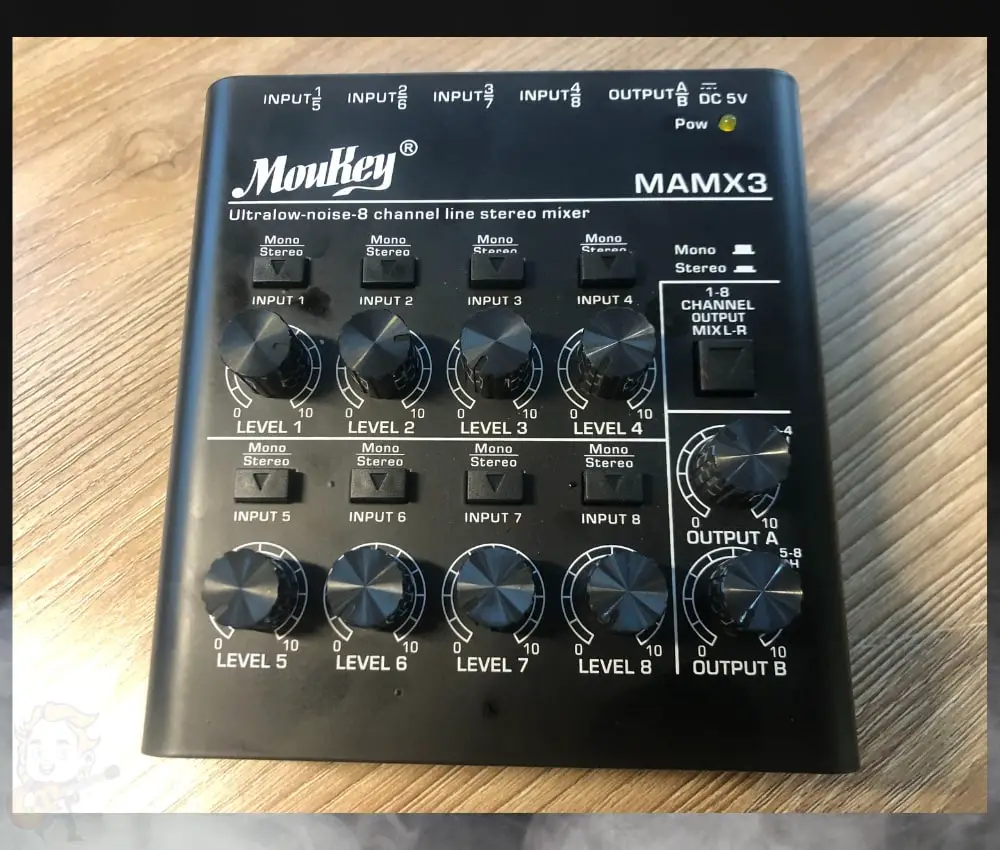
You can also set up the compressor pedal for parallel compression in the FX loop. As it currently stands, I haven’t done this yet but it’s something I’ve considered for a YouTube video.
With something like a Fender “Y” cable, you can divide the signal into two routes, one to the power amp and the other through the compressor. Using a mixer or a parallel effects loop, combine the compressed and uncompressed signals.
To pull something off like this, you would need a splitter cable to split the guitar’s signal into two paths right at the amplifier’s FX Loop send jack.
This approach enables you to keep the uncompressed signal’s original dynamics and punch while adding the compressed signal’s greater sustain and control, resulting in a fuller, more dynamic sound that can be blended to taste and altered in different songs across your set.
Why It’s Best To Put Compression Early In Your Signal Chain?
1) It Gives You A Fairly Consistent Attack
Starting the signal chain with the compressor aids in maintaining consistent attack and picking dynamics.
The compressor can efficiently manage each note’s initial transient, ensuring that lighter picking or fingerpicking preserves its clarity while harder picking retains its impact.
2) It Enhances Your Playing’s Dynamics
According to Origin Effects, the compressed signal gives a more regulated and consistent input for subsequent gain-based effects such as overdrive or distortion pedals.
This means that when you choose harder, the compressed signal keeps clarity without being too distorted, and when you pick softer, it preserves definition and presence.
This is very useful, especially if you’re shredding fast solos and the dynamics of your playing aren’t very even.
3) Improves The Signal-to-Noise Ratio
By applying compression early in the signal chain, you can basically improve your guitar tone’s overall signal-to-noise ratio.
Compression enhances the calmer sections of your performance while dampening the bigger peaks. Due to this, you can boost the overall volume of your guitar signal, thereby decreasing noise and improving the clarity and presence of your performance.
4) Allows You To Control Your Gain Staging
By putting the compressor early in the signal chain, you have greater control over your pedalboard’s gain staging. The compressor can aid in determining the optimal input level for subsequent gain-based effects like overdrive or distortion pedals.
When put before distortion pedals, the compressor can affect the dynamics and responsiveness of the distortion effect.
The compressed signal changes the input level and dynamics when it hits the distortion pedal, influencing the start of saturation and overall sustain.
This interaction can result in a more controllable and consistent distortion tone, which allows for more expressiveness and modulation of the distorted sound.
Important Thing to Note About Compressors in Your Chain
1) The Type of Compression Matters
I have an MXR Dyna-Comp which is a little different in case you don’t know, in the sense that it adds a bit of grit to your sound. A more transparent compressor like the Ego Wampler, in my view, will be more versatile in terms of where you can put it.
Other Articles You May Be Interested In
- Where to Put Distortion In Your Signal Chain (SIMPLE)
- Where To Put the Ditto X2 Looper In Your Signal Chain?
- Where Should A Tremolo Pedal Go In The Signal Chain? [EASY]
- Where Should The Whammy Pedal Go In The Signal Chain? [EASY]
- Where to Put EQ On Your Pedalboard [EASY]


 Written By :
Written By :
